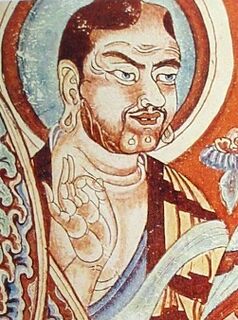Philosophy:Vitarka

| Translations of Vitarka | |
|---|---|
| English | conception selectiveness gross detection examination application of thought applied thinking initial application |
| Sanskrit | vitarka, vitarkah, वितर्क |
| Pali | vitakka |
| Chinese | 尋 (T) / 寻 (S) |
| Korean | 심 (RR: sim) |
| Tibetan | རྟོག་པ། (Wylie: rtog pa; THL: tokpa) |
| Glossary of Buddhism | |
In Buddhism, vitarka is the initial application of attention to a meditational object. It is supplemented with vicara, "sustained thought," deepened attention toward an object.
Mental factor
Vitarka (Sanskrit, also vitarkah; Pali: vitakka; Tibetan phonetic: rtog pa), "thoughts," "applied thought," "attention," "initial application of thought."[1][2] It is "the mental factor that mounts or directs the mind towards an object."[2][note 1]
Vitarka is one of the mental factors (cetasika) that apprehend the quality of an object. It is the first of four or five mental factors that arise in the first dhyana (Pali: jhana). It is the "initial application of attention,"[1][3] the "initial application of the mind to its object."[3] Vitarka investigates things roughly, while vicara investigates things exactly.[4][5][6][7][note 2] Vitarka inhibits the hindrance of sloth and torpor (thina-middha),"[2] and is absent in the higher jhanas.[3][web 2]
Vitarka Mudrā
The Vitarka mudrā, "mudra of discussion," expresses vitarka, joining the tips of the thumb and the index together, and keeping the other fingers straight. This mudra has a great number of variants in Mahayana Buddhism, and is also known as Script error: The function "transl" does not exist. and Vyākhyāna mudrā ("mudra of explanation").
Yoga Sutras of Patanjali
In the Yoga Sutras of Patanjali, vitarka or savitarka describes the nature of consciousness in the first stage of samprajnata-samadhi. In Sutra 1:17 Patanjali tells us that samprajnata samadhi comprises four stages:
Complete high consciousness (samprajnata samadhi) is that which is accompanied by vitarka (reasoning), vicara (reflection), ananda (ecstasy), and asmita (a sense of 'I'-ness or pure beingness).
See also
- Mental factors (Buddhism)
- Sananda Samadhi
- Vicara
Notes
- ↑ According to Nina van Gorkom, the Visuddhimagga ( IV, 88) defines vitakka as follows:
Herein, applied thinking (vitakkama) is applied thought (vitakka); hitting upon, is what is meant. It has the characteristic of directing the mind onto an object (mounting the mind on its object). Its function is to strike at and thresh—for the meditator is said, in virtue of it, to have the object touched and struck at by applied thought. It is manifested as the leading of the mind onto an object.[web 1]
Nina van Gorkom further explains:
The Atthasālinī (Book I, Part IV, Chapter I, 114) [...] uses a simile of someone who wants to “ascend” the king's palace and depends on a relative or friend dear to the king to achieve this. In the same way the citta which is accompanied by vitakka depends on the latter in order to “ascend” to the object, to be directed to the object. Vitakka leads the citta to the object so that citta can cognize it.[web 1] - ↑ Asanga's Abhidharma-samuccaya explains vitarka together with vicara as follows: "What is selectiveness (vitarka)? It is a mental addressing that takes in everything in the wake of intention (chanda) or appreciative discrimination (prajna). It is a coarse mental operation. What is discursiveness (vicara)? It is a mental addressing which is attentive to one thing at it time in the wake of intention or appreciative discrimination. It is an exact mental operation. It has the function of becoming the basis of happiness or unhappiness."[5]
References
- ↑ 1.0 1.1 Buswell & Lopez 2013, p. 983.
- ↑ 2.0 2.1 2.2 Bhikkhu Bodhi 2003, p. 56-57.
- ↑ 3.0 3.1 3.2 Keown 2004, p. 333.
- ↑ Rhys-Davids & Stede1921-25.
- ↑ 5.0 5.1 Guenther & Kawamura 1975, p. Kindle Locations 1030-1033.
- ↑ Kunsang 2004, p. 30.
- ↑ Berzin 2006.
Sources
- Printed sources
- Berzin, Alexander (2006), Primary Minds and the 51 Mental Factors
- Bhikkhu Bodhi (2003), A Comprehensive Manual of Abhidhamma, Pariyatti Publishing
- Buswell; Lopez (2013), The Princeton Dictionary of Buddhism, Princeton University Press
- Guenther, Herbert V.; Kawamura, Leslie S. (1975), Mind in Buddhist Psychology: A Translation of Ye-shes rgyal-mtshan's "The Necklace of Clear Understanding" (Kindle ed.), Dharma Publishing
- Kewon, Damien (2004), A Dictionary of Buddhism, Oxford University Press
- Kunsang, Erik Pema (2004), Gateway to Knowledge, Vol. 1, North Atlantic Books
- The Pali Text Society’s Pali–English dictionary, Pali Text Society), 1921–25, http://dsal.uchicago.edu/cgi-bin/philologic/getobject.pl?c.3:1:1489.pali
- Web-sources
External links
Mahayana tradition:
Theravada tradition:
- Applied thinking and sutained thinking, Nina van Gorkom
- Definition of vitakka, Pali Text Society, Rhys Davids & Stede (1921-25)

